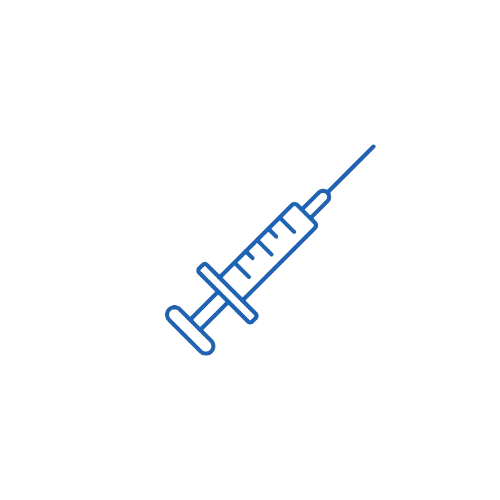Azacitidine
Indications
Approved Indications:
- Myelodysplastic Syndromes (MDS):
Azacitidine is indicated for the treatment of patients with all five French-American-British (FAB) subtypes of MDS—refractory anemia (RA), refractory anemia with ringed sideroblasts (RARS), refractory anemia with excess blasts (RAEB), refractory anemia with excess blasts in transformation (RAEB-T), and chronic myelomonocytic leukemia (CMML). - Acute Myeloid Leukemia (AML):
Approved for adults with newly diagnosed AML who are not candidates for intensive chemotherapy, particularly those aged ≥ 65 years. - Chronic Myelomonocytic Leukemia (CMML):
Used for CMML patients exhibiting ≤20% blasts in the bone marrow without proliferative features.
Important Off-label or Clinically Accepted Uses:
- Maintenance therapy in AML after remission induction.
- Treatment of juvenile myelomonocytic leukemia (JMML) in pediatric populations (investigational or under compassionate use).
- Combination therapy with venetoclax for elderly patients with AML ineligible for intensive induction chemotherapy.
Dosage & Administration
General Adult Dose (Subcutaneous or Intravenous):
- Initial Dose:
75 mg/m² once daily for 7 consecutive days every 28-day cycle. Minimum of 6 cycles is recommended before evaluating response. - Maintenance Therapy:
Continue with 75 mg/m² daily for 5–7 days per cycle based on clinical response and tolerance.
Renal or Hepatic Impairment:
- Use with caution; no formal dose adjustment provided but close monitoring is advised due to limited data.
Elderly Patients:
- No specific dose adjustments required; tolerability should be individually assessed.
Pediatrics:
- Safety and efficacy not well established; investigational dosing used in clinical trials with careful hematologic monitoring.
Route of Administration:
- Subcutaneous Injection: Preferred; rotate injection sites.
- Intravenous Infusion: Administer over 10–40 minutes.
Mechanism of Action (MOA)
Azacitidine is a pyrimidine nucleoside analogue of cytidine that incorporates into DNA and RNA. Its primary action involves inhibition of DNA methyltransferase, leading to hypomethylation of DNA. This reversal of abnormal DNA methylation restores normal gene expression in abnormal hematopoietic cells and promotes differentiation or apoptosis. Additionally, its incorporation into RNA disrupts RNA metabolism and protein synthesis, contributing further to cytotoxic effects in rapidly proliferating abnormal cells, such as in MDS and AML.
Pharmacokinetics
- Absorption:
Nearly complete bioavailability following subcutaneous administration. - Distribution:
Moderate plasma protein binding (~30%). Widely distributed in tissues. - Metabolism:
Primarily metabolized by spontaneous hydrolysis and liver cytidine deaminase. No significant CYP450 metabolism. - Elimination:
Mostly excreted via urine (>50%) as inactive metabolites. - Half-life:
Terminal elimination half-life: 41–51 minutes after subcutaneous administration. - Onset of Action:
Hematologic improvements typically begin after 2–3 cycles. - Bioavailability:
Approx. 89% with subcutaneous administration.
Pregnancy Category & Lactation
- Pregnancy:
Azacitidine is classified as FDA Pregnancy Category D (positive evidence of human fetal risk). It is teratogenic and embryotoxic in animal studies. Not recommended during pregnancy unless no alternatives exist. - Lactation:
Unknown whether excreted in human breast milk. Due to potential for serious adverse reactions in nursing infants, breastfeeding should be discontinued during therapy and for at least 1 week after the last dose. - Contraception Advice:
Effective contraception is recommended for both males and females during treatment and for at least 3 months post-therapy.
Therapeutic Class
- Primary Class:
Antineoplastic Agent - Subclass:
DNA Hypomethylating Agent
(Also classified as a cytidine nucleoside analogue)
Contraindications
- Known hypersensitivity to azacitidine or mannitol.
- Advanced malignant hepatic tumors.
- Severe hepatic impairment (especially with bilirubin >2 × ULN).
- Uncontrolled infections or active bleeding due to thrombocytopenia.
Warnings & Precautions
- Myelosuppression:
Common and often severe; requires frequent complete blood count (CBC) monitoring and possible dose delays or reductions. - Renal Toxicity:
May cause renal tubular acidosis or elevated creatinine. Use cautiously in patients with renal impairment. - Hepatic Impairment:
Use is contraindicated in advanced hepatic malignancies; monitor liver enzymes closely. - Hypersensitivity Reactions:
Rare cases of anaphylaxis have occurred—monitor for early signs during initial doses. - Tumor Lysis Syndrome:
Particularly in patients with high tumor burden—monitor electrolytes and renal function. - Injection Site Reactions:
Common with subcutaneous administration; rotate sites and monitor for skin necrosis.
Side Effects
Common Side Effects:
- Hematologic: Neutropenia, thrombocytopenia, anemia, febrile neutropenia
- Gastrointestinal: Nausea, vomiting, constipation, diarrhea, anorexia
- General: Fatigue, pyrexia, injection site erythema, weakness
Serious and Rare Adverse Effects:
- Sepsis
- Anaphylaxis
- Pneumonia
- Hepatotoxicity
- Renal tubular acidosis
- Tumor lysis syndrome
- QT prolongation (rare)
Timing & Severity:
Most hematologic effects are dose-dependent and occur within the first few cycles. Gastrointestinal effects typically appear early but may subside with continued treatment.
Drug Interactions
- Live Vaccines:
Avoid concomitant use due to immunosuppression risk. - Nephrotoxic Agents (e.g., aminoglycosides):
Increased risk of renal toxicity. - CYP450 Interactions:
Azacitidine does not significantly interact with CYP enzymes; minimal drug-drug interaction via this pathway. - Other Myelosuppressants:
Additive hematologic toxicity when combined with other chemotherapy agents or radiation. - Alcohol:
No direct interaction, but alcohol may worsen liver toxicity and hematologic suppression.
Recent Updates or Guidelines
- FDA (2020):
Approved azacitidine (oral formulation) in combination with venetoclax for newly diagnosed AML in elderly or unfit patients. - NCCN Guidelines (2023):
Recommends azacitidine as part of first-line treatment for AML in patients not eligible for intensive chemotherapy. - EMA (2022):
Endorsed extended use in low-blast count AML and highlighted role in maintenance therapy post-remission.
Storage Conditions
- Powder for Injection:
Store vials at 2°C to 8°C (refrigerated). - After Reconstitution (with sterile water):
- Subcutaneous/IV use: Use within 1 hour at room temperature, or refrigerate up to 22 hours.
- Do not freeze reconstituted solution.
- Protect From Light:
Keep vials in the original carton until use. - Handling:
Use gloves when handling; cytotoxic precautions should be followed during preparation and administration.

